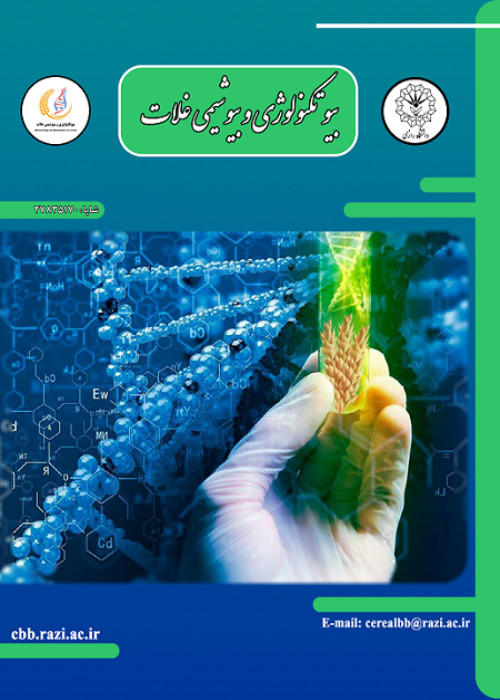Yield changes and some physiological responses of different bread wheat genotypes under terminal water deficit stress
Author(s):
Article Type:
Research/Original Article (دارای رتبه معتبر)
Abstract:
Introduction
Wheat is a strategic product in the world's food security, as it occupies one-sixth of the world's cultivated area. It is the main food crop in Iran, and at the same time, most of the cultivated areas of this crop face environmental stresses such as drought, which leads to a decrease in its yield. Drought stress causes a wide range of plant reactions, including growth and yield changes. Therefore, to achieve maximum adaptability and yield in drought conditions, the present experiment was conducted in Karaj's climatic conditions on eight important wheat genotypes (obtained from the National Plant Gene Bank of Iran).Materials and methods
The experiment was conducted as a split-plot design based on randomized complete block design (RCBD) with three replicates during the 2016-2017 cropping season in Karaj. The main factor was the irrigation regime at two levels, including control (irrigation based on the water requirement of the plant during the growth period until physiological maturity) and water deficit stress (interruption of irrigation from the beginning of spike appearance until physiological maturity) in the main plots and eight different bread wheat genotypes (Star, Sirvan, Roshan, Mehrgan, 2019, 3737, 3729, and 4228) in the sub-plots. Seed yield and physiological traits, including leaf relative water content, leaf photosynthetic pigment content, leaf proline content, and the activity of antioxidant enzymes (catalase and superoxide dismutase) were measured at the end of grain filling stage; then, data analyzed using principal component analysis and cluster analysis.Results
According to the results, a significant difference was observed between different genotypes of wheat in terms of reduced biological yield and grain yield under water deficit stress compared to the control treatment. In these conditions, the highest and lowest decrease in grain yield was observed in genotypes 3737 (47%) and 4228 (24%), respectively. Also, the content of photosynthetic pigments and the relative water content of the studied genotypes decreased under water deficit condition. Despite the decrease in "chlorophyll a" content in genotypes 4228 and 3729, there was no significant difference with the control treatment under water deficit conditions. The most changes in these conditions were related to Genotype 3737, with a 25% decrease compared to the control treatment. Contrary to plant performance, leaf proline content increased as an important factor in water deficit conditions. The highest accumulation of proline in leaves was observed in Genotype 4228 at 9.1 times under water deficit conditions and the lowest amount in Genotype 3729 at 2.5 times compared to normal irrigation conditions. The results of principal component analysis (PCA) showed that Genotypes 4228 and 3729 had a negative and significant relationship with Mehregan and Star. The results of agglomerative hierarchical clustering (AHC) demonstrated that Genotypes 3729 and 4228 were placed in Cluster 1, genotypes 1399, 3737 and Sirvan were grouped together in Cluster 2, and Genotypes Star, Mehrgan and Roshan were located in Cluster 3.Conclusion
Physiological responses of bread wheat genotypes to water deficit stress at the end of the growing season were different, which caused different alternations in the growth and yield of plants under water deficit conditions.Language:
Persian
Published:
Journal of cereal Biotechnology and biochemistry, Volume:2 Issue: 2, 2023
Pages:
170 to 189
magiran.com/p2617078
دانلود و مطالعه متن این مقاله با یکی از روشهای زیر امکان پذیر است:
اشتراک شخصی
با عضویت و پرداخت آنلاین حق اشتراک یکساله به مبلغ 1,390,000ريال میتوانید 70 عنوان مطلب دانلود کنید!
اشتراک سازمانی
به کتابخانه دانشگاه یا محل کار خود پیشنهاد کنید تا اشتراک سازمانی این پایگاه را برای دسترسی نامحدود همه کاربران به متن مطالب تهیه نمایند!
توجه!
- حق عضویت دریافتی صرف حمایت از نشریات عضو و نگهداری، تکمیل و توسعه مگیران میشود.
- پرداخت حق اشتراک و دانلود مقالات اجازه بازنشر آن در سایر رسانههای چاپی و دیجیتال را به کاربر نمیدهد.
In order to view content subscription is required
Personal subscription
Subscribe magiran.com for 70 € euros via PayPal and download 70 articles during a year.
Organization subscription
Please contact us to subscribe your university or library for unlimited access!


